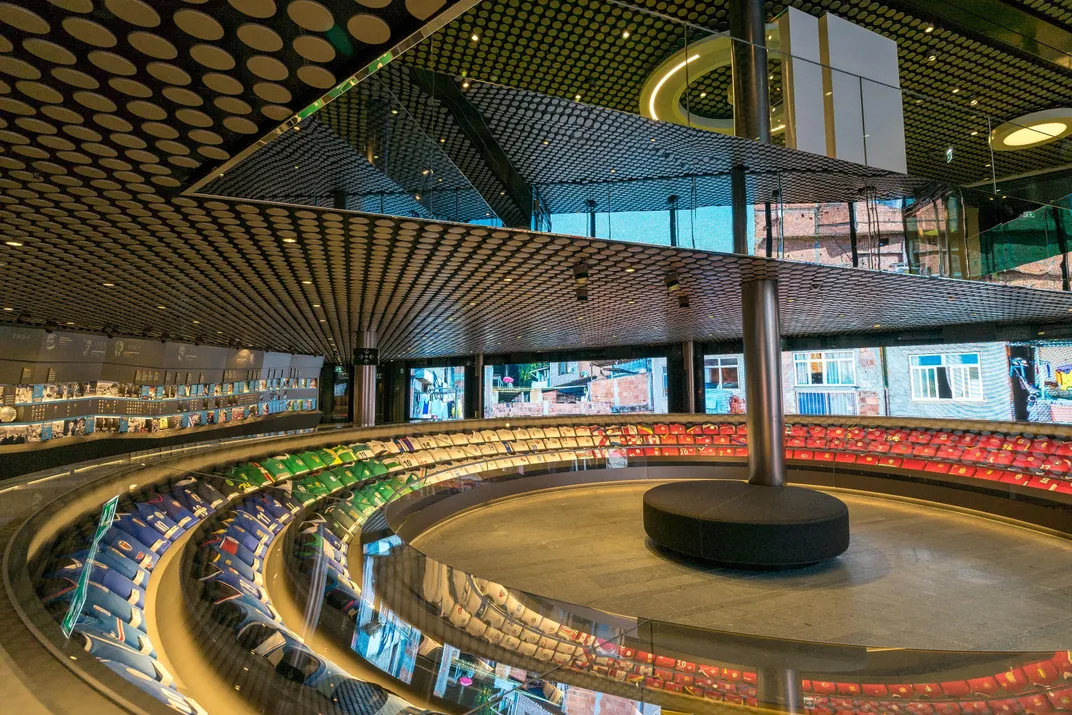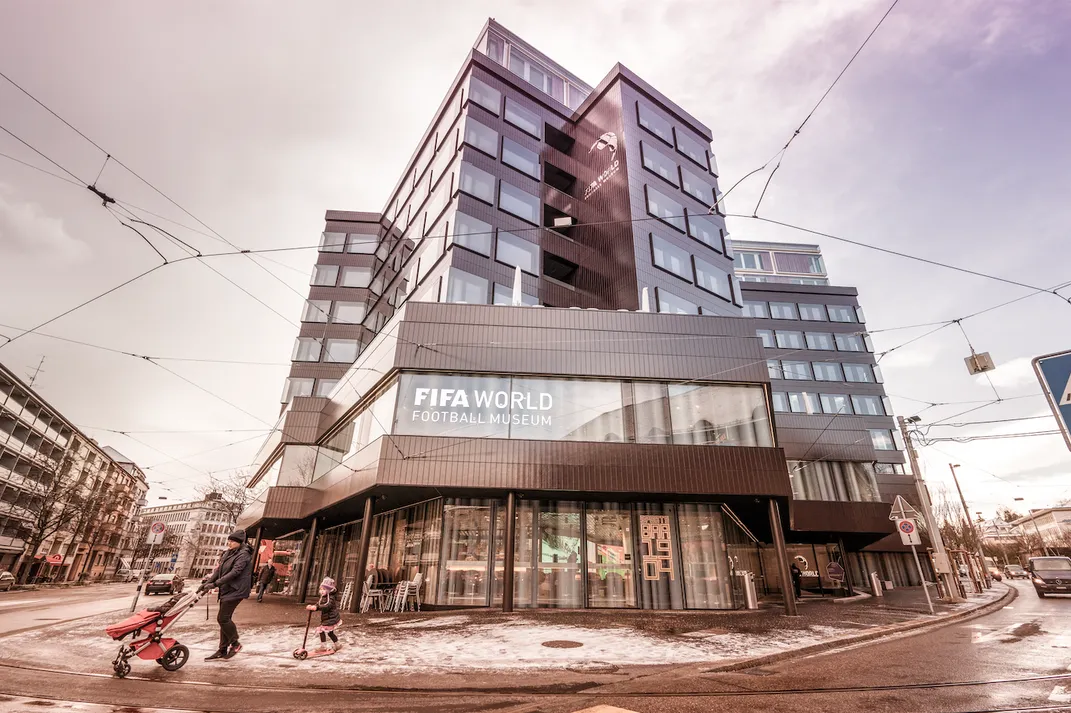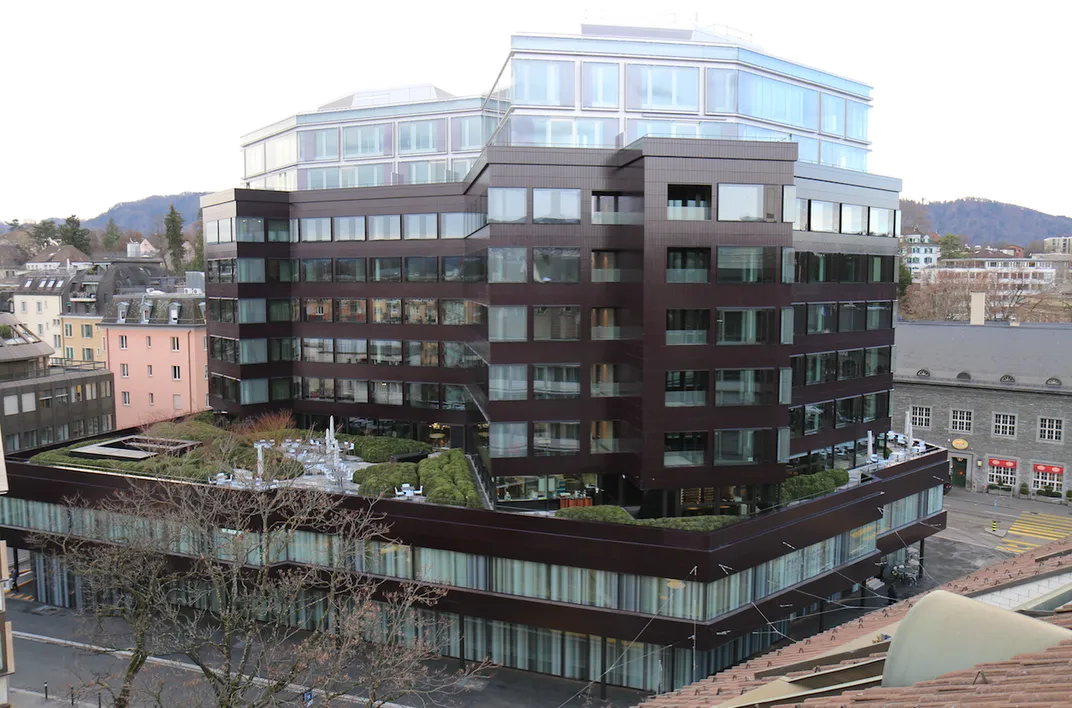These Five Objects Tell the Story of Soccer
Take an exclusive look inside the new FIFA World Football Museum in Zurich
Visitors to the new FIFA World Football Museum in Zurich, Switzerland, which opened Sunday, will be greeted not by one of the sport’s iconic black-and-white spheres, but by a five-ton rainbow. A collection of 209 jerseys collected from FIFA teams all around the world, arranged by color, illustrates soccer's global reach.
It's all part of a museum that took three years to plan and cost nearly $140 million to build. David Ausseil, the creative director of the museum, says its goal is to create a place that soccer fans everywhere would love to see. "It is the world that made football what it is today," he tells Smithsonian.com. "Our museum shows the rich heritage of the game and how football connects and inspires the world."
Though hints of soccer's embattled present are visible throughout the museum, the bulk of the exhibits focus on the sport's past. A visit to the museum begins on a ground floor appropriately named "Planet Football." Visitors start their journey through the history of soccer with a timeline that tells the story of the game, from its birth in England during the 19th century through today. Other walls are taken over by LED screens that show film of children and adults—beginners and skilled players alike—kicking soccer balls in slow motion.
The second level of the museum, which is underground, explores FIFA's founding in 1904 and the pledge the founders made to take the game from the British Isles to the world. The main room hosts a glittering array of FIFA World Cup trophies, each accompanied by an artist's poster commissioned for the museum. Giant screens play the greatest moments from World Cups, and a special cinema shows a short film mashup in which players from different World Cups kick the ball in a seemingly seamless soccer game of historic greats.
From there, visitors can watch soccer enthusiasts share their stories of the game. "We tried to make the stories amusing or thought-provoking," Ausseil says. The floor of this room is made of green and white lines—a testament to just how deeply soccer has invaded people's lives.
FIFA has faced a rough road of late. Preparations for the museum, which is housed in the iconic 1970s “Haus zur Enge” in Zurich-Enge, started in 2013 and were signed into being by then-president Joseph "Sepp" Blatter. The permanent exhibit's concept was produced before the United States indicted 30 current and former FIFA officials and associates on charges of corruption. Blatter himself was among those in power ousted on charges, which included "criminal schemes involving well over $200m...in bribes and kickbacks," as the BBC reports. But things might be looking up. The organization just elected a new president, Gianni Infantino, and early reviews of the museum have been positive. As the Guardian wrote, it's a "nerds’ nirvana untouched by [the scandal's] grubby reality."
The museum does plan to include the recent scandal within its educational scope. "We know the public will want to ask us what happened, what FIFA did and how it is mending, and what are the new things that FIFA is putting in place," Ausseil tells Smithsonian.com. During the opening ceremony, Infantino spoke about reforms that will be implemented in the organization. In the future, the museum says it will also hold lectures on FIFA's corruption in its conference rooms.
For Ausseil, his favorite object in the collection is the rainbow, as it represents the universal bonds forged by the sport. Here's an exclusive glimpse at five of Ausseil's other favorite artifacts from the museum—objects that show the sport's colorful impact on the world.
The Jules Rimet Cup (France, 1930)
/https://tf-cmsv2-smithsonianmag-media.s3.amazonaws.com/filer/05/d2/05d2c0af-89e2-4b82-a890-4b6eeffe957d/jules_rimet_cup03_small_1024.jpg)
The Jules Rimet Cup is the trophy awarded to the winner of the World Cup. "It's the absolute dream," Ausseil tells Smithsonian.com. "Any footballer wants to win it. The World Cup is the pinnacle of soccer. This trophy is the first symbol for the first winners of the event back in 1930, and that’s the first reason why I chose it."
The 1930 cup’s story doesn’t end there: It was stolen twice, first in England in 1966 and then in Brazil in 1983. One of FIFA's historians found the object now on display—a piece of lapis lazuli, a semi-precious stone that was part of the trophy's base in 1930—in an old box while doing research in the FIFA archives.
"The golden part is a copy, but the base is the real one," Ausseil tells Smithsonian.com. "Against all odds, here is a genuine piece of the 1930s Cup."
Pelé tracksuit (FIFA World Cup, Sweden 1958)
/https://tf-cmsv2-smithsonianmag-media.s3.amazonaws.com/filer/e3/8a/e38a0683-859c-44b0-bb60-c371d4cb5f06/1958_bra_pele_front_smal_smalll.jpg)
Edson Arantes do Nascimento, better known as Pelé, was soccer’s first global star. Before the young prodigy joined the Brazilian team, Brazil had never won the World Cup before. In 1958, he scored the team’s winning goal in the World Cup final, securing victory before fainting on the field—all while just 17 years old. He’s been “the idol of the public ever since," Ausseil tells Smithsonian.com. "He's a great soccer ambassador, Brazil ambassador, one of the most loved and the biggest stars the game ever produced."
When curators saw the tracksuit Pelé wore in 1958, they knew it was a must-have. "It was too beautiful not to be in our museum," Ausseil says. "It is a symbol of the first world star that the game produced, the only player in world history to win three World Cups. That's not something that will happen [again] anytime soon. It's difficult to dominate the game the way he has."
Shovel from Robben Island penitentiary (off Cape Town, South Africa)
/https://tf-cmsv2-smithsonianmag-media.s3.amazonaws.com/filer/4e/01/4e015d32-4f00-4751-bd32-47ebbc315029/img_0995_small.jpg)
Six years ago, FIFA took the World Cup to South Africa, a huge event that required massive organization and outreach. While there, Robben Island, the South African prison that held political prisoners, notably Nelson Mandela, caught FIFA's attention. "One of the things that kept the prisoners' mental resistance through the brutal regime of apartheid was football," Ausseil tells Smithsonian.com.
While in jail, prisoners created the Makana Football Association and organized football tournaments with other inmates. "That kept their hopes alive, their spirits up, and it was a great tool to resist the brutality of the regime," says Ausseil. The shovel he selected was used by inmates at Robben's Island who were forced to work at the limestone quarry and played soccer in rare moments of escapism.
It's also part of the personal story of one of the prison's inmates, Tokyo Sexwale, a South African businessman who recently ran to become FIFA's president. Sexwale was imprisoned at Robben Island along with Mandela and, in the years since his release, has become a soccer financier and a supporter of anti-racism initiatives within FIFA.
Model of the Telstar satellite (FIFA World Cup Mexico 1970)
/https://tf-cmsv2-smithsonianmag-media.s3.amazonaws.com/filer/12/d5/12d57a86-5332-40c2-bd3a-d33d438bc738/11_1970_telstar_satellite_model_small_small.jpg)
One of the greatest World Cups, and the third one won by Pelé for Brazil, was the 1970 World Cup held in Mexico. But that year's competition was memorable for another reason: It was the first time a ball made of black and white hexagons was used in soccer. Previously, balls were all different colors and designs.
The 1970 ball, however, was created by Adidas to show up better on TV. As the official soccer ball of the Mexico cup, it was the first time a sports equipment company produced a football specially for an event. Adidas named its new ball the "Telstar" after the Telstar satellite, which itself resembled a white sphere with black patches. The Telstar was used to beam television broadcasts of that year's World Cup—the first ever to be broadcast live and in color.
"It's immensely important, the beginning of a new era of live World Cup coverage all around the world," Ausseil tells Smithsonian.com. "When you ask about the impact football makes on the world, it is impossible not to link this."
Shirt of Japan world champion Kozue Ando (FIFA Women’s World Cup, Germany 2011)
/https://tf-cmsv2-smithsonianmag-media.s3.amazonaws.com/filer/ca/a9/caa97988-7ec9-42d3-8e41-f972c91caa1e/jpg_ando_front_small_small.jpg)
In 2011, the German women’s national team was favored to win the World Cup, which was held in Germany that year. But in an upset, the Japan national team defeated the host country and took home the World Cup for the first time. One of the game's dominant performances was by Kozue Ando, Japan's midfielder.
"An Asian team winning one of FIFAs major competitions really meant that there were ready-to-win favorites on each continent for the Cup," Ausseil tells Smithsonian.com. "It's a beautiful result of FIFA trying to develop the game all over, develop the mission of football. [We've] succeeded beyond our wildest dreams, so I wanted to take Kozue Ando's shirt, which is such a great example of winning mentality."



